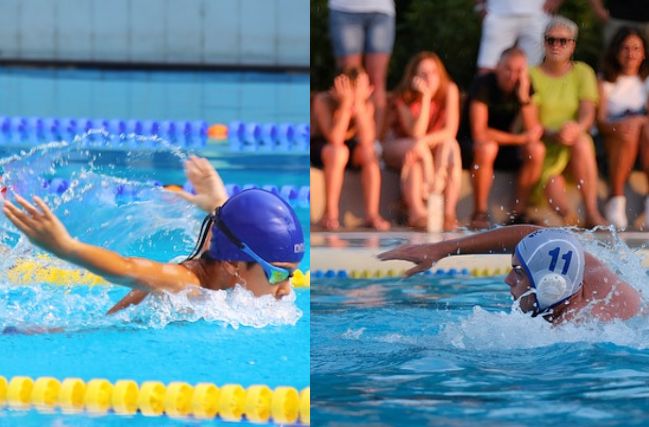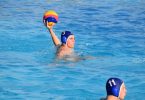Swimming and water polo are two sports that require a high level of aquatic skill and physical fitness. While both sports involve spending a lot of time in the water, there are some key differences between them that can affect how fast a person can swim. In this article, we’ll explore the question of who would swim faster, a swimmer or a water polo player.
We’ll examine the unique physical demands of each sport, as well as the techniques and training methods used by athletes in each discipline.
Whether you’re a swimmer, a water polo player, or simply curious about the differences between these two sports, this article will provide you with valuable insights into the factors that can affect swimming speed. So, let’s dive in and explore the question of who would swim faster, a swimmer or a water polo player.
Who would swim faster, a swimmer or a water polo player
While water polo players also need to be strong swimmers, their focus is on different skills, such as ball handling, passing, and shooting. In fact, research has shown that swimmers have the edge over water polo players in swim speed in short and long distances, which is consistent with their initial hypothesis.
However, it’s important to note that swimming and water polo are two different sports that require different skill sets. Just because a swimmer would swim faster than a water polo player, it doesn’t mean that one sport is better than the other. Both sports have their own unique challenges and benefits, and it ultimately comes down to personal preference and individual goals.
Swimming Technique and Training
When it comes to swimming faster, technique and training play a crucial role. In this section, we will take a closer look at the swimming techniques and training methods that can help you improve your swimming performance.
Swimming Techniques
Swimming technique is all about maximizing your efficiency in the water. Here are some techniques that can help you swim faster:
- Maintain a streamlined body position by keeping your head down, hips up, and legs close together.
- Use a high elbow catch to create a powerful pull and maximize your stroke length.
- Focus on your breathing technique to ensure that you are getting enough oxygen during your swim.
- Practice your turns to ensure that you are not losing any speed during your transitions.
Swimming Training
Swimming training is all about building up your endurance, strength, and speed in the water. Here are some training methods that can help you swim faster:
- Interval training: This involves swimming at a high intensity for a set period of time, followed by a period of rest, and then repeating the cycle.
- Strength training: This involves incorporating resistance exercises into your training routine to build up your muscle strength and power.
- Technique drills: This involves practicing specific swimming techniques to improve your form and efficiency in the water.
- Endurance training: This involves gradually increasing the distance and duration of your swims to build up your endurance and stamina.
Remember, improving your swimming performance takes time, dedication, and practice. By focusing on your technique and training, you can take your swimming to the next level and improve your overall speed and performance in the water.
Water Polo Technique and Training
Water Polo Techniques
Water polo demands a combination of swimming, ball-handling, and shooting skills as it is a physically demanding sport. The sport’s unique rules and strategies require specialized techniques that differ from traditional swimming strokes.
One of the most essential techniques in water polo is eggbeater kick, which allows players to maintain an upright position in the water while using their arms to handle the ball. This technique involves alternating circular movements with both legs to create a continuous propelling motion.
Another crucial technique is the shooting technique. Players must be able to shoot accurately and powerfully while treading water.
The two main shooting techniques are the wrist shot and the backhand shot. The wrist shot involves flicking the wrist to shoot the ball, while the backhand shot requires players to use the back of their hand to shoot the ball.
Water Polo Training
To excel in water polo, players must undergo rigorous training that focuses on developing their swimming and ball-handling skills.
Swimming drills are an essential part of water polo training. These drills focus on improving a player’s endurance, speed, and overall swimming technique. For example, a common swimming drill is the 25-meter sprint, where players swim as fast as possible for 25 meters to improve their sprinting speed.
Ball-handling drills are also crucial to water polo training. These drills focus on improving a player’s ability to handle the ball while treading water. For example, a common ball-handling drill is the “water polo catch and pass” drill, where players practice catching and passing the ball while treading water.
In addition to swimming and ball-handling drills, water polo players must also focus on strength and conditioning training. This training includes exercises such as weightlifting, plyometrics, and core training to improve overall strength and endurance.
Overall, water polo requires a unique set of techniques and training methods that differ from traditional swimming. By focusing on these specialized techniques and training methods, players can improve their performance and become more competitive in the sport.
Comparison of Swimming and Water Polo
If you are wondering who would swim faster, a swimmer or a water polo player, it is important to understand the differences between the two sports.
Here is a comparison of swimming and water polo in terms of physical demands, technical requirements, and competition formats.
Physical Demands
Swimming demands a high level of cardiovascular fitness, endurance, and strength. Swimmers need to have a streamlined body shape and be able to maintain an efficient swimming technique for long periods of time.
Water polo, on the other hand, requires a combination of swimming, strength, and endurance. Players need to be able to swim for long periods of time while also being able to handle the physical demands of the sport, such as grappling and pushing opponents in the water.
Overall, both sports require a high level of physical fitness, but the specific demands are different.
Technical Requirements
Swimming is a highly technical sport that requires a lot of skill and practice to master. Swimmers need to have a good understanding of the various strokes and be able to execute them with precision.
Water polo also requires technical skill, but the focus is more on ball handling and passing than on swimming technique. Players need to be able to handle the ball while treading water and be able to pass accurately to teammates.
Overall, both sports require technical skill, but the specific requirements are different.
Competition Formats
Swimming competitions typically involve individual races and relays, with swimmers competing against each other to see who can swim the fastest.
Water polo competitions involve teams of players competing against each other to score goals and prevent the other team from scoring. The game is played in four quarters, with each team trying to score as many goals as possible.
Overall, the competition formats are different, with swimming being more focused on individual performance and water polo being more focused on team performance.
Conclusion
Based on the research and analysis of the available data, it is safe to say that a swimmer would generally be faster than a water polo player in a swimming race.
Swimmers have the advantage of being able to focus solely on their swimming technique and speed, whereas water polo players have to balance their swimming skills with other skills required for the game. While water polo players may not be as fast as swimmers in a straight swimming race, they have other skills that make them valuable players in their sport.
Water polo requires a combination of swimming speed, agility, endurance, ball handling skills, and strategy. Therefore, it is not fair to compare the two sports solely based on swimming speed. It is important to note that there may be exceptions to this generalization.
Some water polo players may have exceptional swimming speed and technique, which could make them competitive in a swimming race. Additionally, some swimmers may not have the endurance or agility required for water polo, which could make them less successful in that sport.
Ultimately, the choice between swimming and water polo should be based on personal interests, goals, and strengths. Both sports offer unique challenges and opportunities for growth and development. Whether you choose to pursue swimming or water polo, focus on improving your skills and techniques to become the best athlete you can be.







